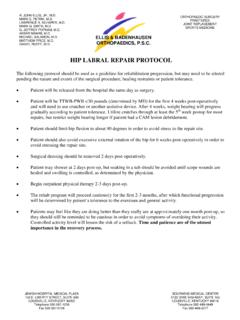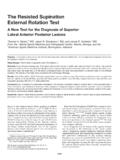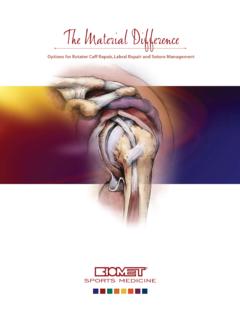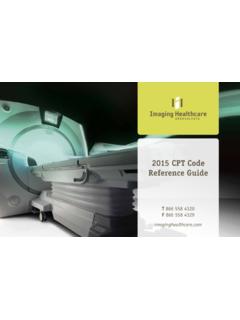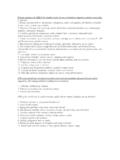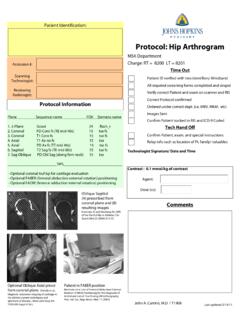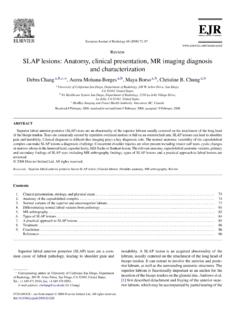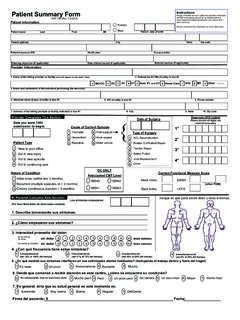Transcription of Acetabular Labral Tears With Underlying Chondromalacia: A ...
1 Acetabular Labral Tears With Underlying chondromalacia : A Possible Association With High-Level Running Carlos A. Guanche, , and Robby S. Sikka, Purpose: The use of hip arthroscopy has helped delineate intra-articular pathology and has enabled clinicians to further elucidate the factors responsible for injuries, such as running. The subtle development of degenerative changes may be a result of repetitive impact loading associated with this sport. This study presents a population of runners with common pathologic Acetabular changes.
2 Type of Study: Case series. Methods: Eight high-level runners with an average age of 36 years (range, 19. to 45 years) were seen for complaints of increasing hip pain with running without any history of macrotrauma. All of the patients had either run several marathons (4), were triathletes (1), Olympic middle distance runners (1), or had run more than 10 miles per week for longer than 5 years (2). Plain radiographic analysis revealed no degenerative changes and an average center-edge (CE) angle of (range, 28 to 44 ). Results: All patients underwent hip arthroscopy with Labral debridement.
3 In 6 patients (75%), a chondral injury of the Acetabular cartilage Underlying the Labral tear was noted. In addition, 3 patients had ligamentum teres disruptions. Conclusions: It is possible that the development of these Tears is the result of subtle instability, which may be exacerbated by running, eventually leading to Labral tearing and possible ligamentum teres disruption. While perhaps con- currently, subtle Acetabular dysplasia may play a role. Although this study does not confirm an association between running and the development of Labral Tears or chondral lesions in the hip, it certainly questions whether there is an injury pattern common to this population, a runner's hip.
4 Level of Evidence: Level IV. Key Words: Hip Arthroscopy Hip injuries Running Acetab- ular labrum Ligamentum teres. R ecently, an explosion in the knowledge of hip pathology has occurred. The impetus has been the increasing use of magnetic resonance imaging of the hip in 1957. In these cases the displaced labrum was shown to be a block to concentric reduction of the hip. More subtle disruptions of the Acetabular labrum (MRI) and MRI arthrography as well as arthroscopy to were not reported until 1977, when 2 cases of hip pain evaluate hip injuries.
5 Increasingly, diagnostic and sur- without dislocation or major trauma were document- gical procedures are being performed to evaluate in- These patients were treated by arthrotomy and tra-articular problems previously dealt with infre- partial resection of the labrum. This study was the first quently, if at all. to show that Acetabular Labral Tears could present as Tears of the Acetabular labrum are often dealt with the primary cause of hip pain and it led to further arthroscopically. Patterson1 first described a torn ace- analysis of the Acetabular labrum.
6 Between 1986 and tabular labrum associated with posterior dislocations 1996, there were several reports on the relationship between dysplasia and Acetabular Labral ,4 Dor- rell and Catterall5 described 1 case of Acetabular Labral From the Southern California Orthopedic Institute, Van Nuys, Tears associated with developmental dysplasia. Also California, Ikeda et reported on 7 patients with arthroscopi- Address correspondence and reprint requests to Carlos A. Guanche, , Southern California Orthopedic Institute, 6815 Noble cally documented Labral Tears associated with dysplas- Ave, Van Nuys, CA 91405, E-mail: tic conditions of the hip.
7 2005 by the Arthroscopy Association of North America 0749-8063/05/2105-4102$ More recently, femoroacetabular impingement has been postulated as a cause of Labral damage with 580 Arthroscopy: The Journal of Arthroscopic and Related Surgery, Vol 21, No 5 (May), 2005: pp 580-585. Acetabular Labral Tears AND chondromalacia 581. repetitive flexion and internal rotation of the In METHODS. addition, the converse has been postulated by Mc- Carthy and Based on the reproduction of groin Between March 2000 and May 2003, 162 hip ar- pain with hip extension, rather than flexion/rotation, throscopies were performed by the senior author the mechanism of Labral degeneration is that of hyper- ( ).
8 A retrospective review of these patients was extension and torsional forces acting on the labrum performed to identify high-level runners within the group. The definition of a high-level runner was either and subjacent articular an Olympic or college runner or a person having One group of patients that are prone to hip difficul- participated in more than 5 marathons. Eight high- ties is runners. The subtle development of degenera- level runners with an average age of 36 years (range, tive changes may be a result of repetitive impact 19 to 45 years) were identified.
9 Six patients were loading associated with running and the rate of degen- female and 2 were male, with the right hip joint eration may be exacerbated by the presence of subtle affected in 5. None of the subjects had any Underlying Acetabular deformities (possibly congenital). In addi- pathologic condition or history of macrotrauma to the tion, subtle instability with consequent hyperextension extremity. Medical records, imaging studies, and ar- in the stride phase may be a source of recurrent throscopic findings were reviewed.
10 All patients were subluxation and possibly attritional tearing of the la- given the Western Ontario and McMaster Universities However, the exact association between repeti- Osteoarthritis Index (WOMAC) survey at their fol- tive impact and degeneration of the hip joint as a whole, low-up The duration of clinical and or the labrum in particular, has yet to be ,11 radiographic follow-up ranged from 6 to 29 months Intuitively, there may be an association between sub- (average, 14 months). tle dysplasia and the development of hip joint degen- eration in competitive runners.

